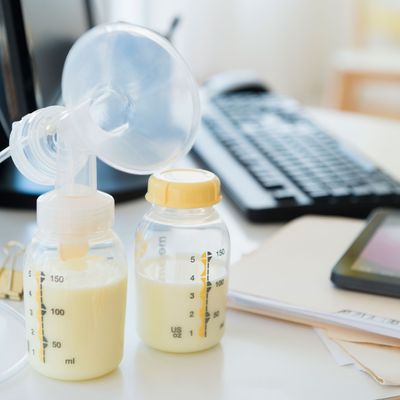
Let me start by saying my employer — this publication — is very accommodating of breastfeeding, which in practical terms means expressing milk at the office. Twice a day, I use an electric breast pump to express five or six ounces, which I bring home to my 4-month-old. Until then, the milk lives in a mini-fridge provided by my employer at my desk. I could work from home, if I wanted to (I don’t). Here, I have access to a private, quiet place with a lock and a sign that flips to indicate the room is occupied. When I pump there, no one bothers me.
But what if, instead of scurrying away, I slipped breast shields under my shirt, switched my pump on, and went for it — all without leaving my desk?
Hear me out: I’m not saying anyone should have to work while pumping. Plenty of women straight-up can’t work and pump, or aren’t given proper opportunities to do so, despite protective laws. Milk often flows best when you’re able to replicate the emotions and physical sensations of breastfeeding, which can be tough to pull off at the office: Common tips include looking at pictures or videos of your baby, lying back, closing your eyes, or even smelling a blanket or toy. Some unlucky women are plagued by lactation-induced despondency. Others may simply not be into having their nipples yanked within spitting distance of their co-workers.
For those of us comfortable with the idea, however, I propose: Let’s just pump at our goddamned desks.
Sure, if I want to work and pump at the same time, I could haul my personal laptop into the private room with me. But first, I’d have to haul it to the office, and I already commute with two sets of pump accessories, a bulky electronic breast pump, plus milk containers and their cooler.
Just getting to the room and setting everything up takes time, and since it’s used by many of my co-workers, I feel bad about monopolizing it. The room’s popularity also means it’s not always free when I need it, which extends the time I’m not working and instead roaming the halls with all my stuff, searching for alternate locations. In a lot of ways, it would be much easier to just strap myself in and keep working.
Electric breast pumps do make a bit of noise — but so do co-workers. All of whom, by the way, I would breastfeed my baby in front of, should the need somehow arise. Is pumping any different? Yes, I would argue. And no.
Pumping is different because, most of the time, it’s done during the workday, in places babies usually are not. There’s no cute-baby visual to explain why you’re briefly exposing your breasts, nor the baby’s (sometimes) cute noises. While you’re pumping, bottles hang off your chest and milk flows into them. Quieter, sleeker pumps are starting to creep into the market, but aren’t commonplace yet. For now, plastic squelches as it suctions against skin, a motor wheezes with every crank of the dial. There’s nothing cute about it.
Despite its contrasts to breastfeeding, though, pumping is just another form of feeding your baby breast milk, which the American Academy of Pediatricians recommends doing for at least a year. By law, employers with 50 or more employees are required to provide breaks and a non-bathroom location for mothers to express milk. Much is made of creating a special space for breastfeeding mothers to pump in, and that’s great. Those who need and want privacy to pump should be accommodated.
But those who’d rather throw a wide scarf over their shoulders and go to town should be accommodated, too. Without rushing off to assemble and use the pump elsewhere, you get more done. Getting more done means less stress, which could mean a better milk supply.
Beyond these practical victories, I feel a sense of political conviction about pumping openly. No one — besides like three idiotic men who frequent Target cafés — wants women to nurse in secret caves. So why aren’t we pumping where we breastfeed, out in the open?
The quick answer is that it might be weird. Seven years ago, when pointing out that the obscenity factor of pumping in public remained untested, The New Yorker’s Jill Lepore asked, “Honestly, who would want to?” Me. I wanted to. Rather, I wanted someone braver than me to go first and establish a precedent.
Earlier this month, I got my wish when Lynda Mazzalai Nguyen, a breastfeeding mother, attended a seminar at a hotel and asked the front desk about a private place to pump. Two hotel employees told her there was no such place available and that she should pump in the bathroom. In protest, she pumped in the lobby.
Her subsequent Facebook post describing the incident went viral; as of this writing, it’s been liked 14,000 times and shared more than 20,000. The post brims with rage — a rage I recognize because I’ve felt it, just like every other mother frustrated by policy and circumstance and the desire to do what she needs for her child, whatever that may mean.
For Nguyen, it means being vehemently opposed to pumping in a bathroom. Privacy is less of a concern: “I’m fine with windows!” she writes. Same here.
So recently, when my office’s designated space was occupied, I pumped in a different room, with just frosted glass between me and passers-by. It was fine. Then I started experimenting with pumping in different places — a co-worker’s semi-private cubicle, and one day, when I was impossibly busy, at my own desk. It seemed scary at first, but I finished everything I had to do, got over my fear, and went home on time. Then I did it again, and again. Now I do it regularly, wearing a cover-up that looks like an adult-size bib. My co-workers don’t seem to care.
In the absence of supportive policies, women have found a zillion different ways to provide food for their babies. I’m glad my desk-pumping is a success so far, but still feel a little queasy about the possible implications — that public pumping is the best way, that breastfeeding is something every mother who physically can should do, that your work should take precedent over things like breaks and mental space. My resolve, like the amount of milk I’m able to express, varies day by day.





